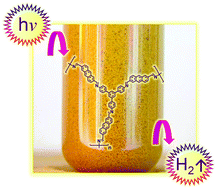Photocatalytic hydrogen evolution through fully conjugated poly(azomethine) networks†
Abstract
Three-dimensional conjugated poly(azomethine) networks were found to be promising candidates for applications in photocatalytic

* Corresponding authors
a
Max-Planck-Institute for Polymer Research, Ackermannweg 10, D-55128 Mainz, Germany
E-mail:
muellen@mpip-mainz.mpg.de
Fax: +49 6131-379100
Tel: +49 6131-379151
b
Max Planck Institute of Colloids and Interfaces, Research Campus Golm, D-14424 Potsdam, Germany
E-mail:
xinchen.wang@mpikg.mpg.de
Three-dimensional conjugated poly(azomethine) networks were found to be promising candidates for applications in photocatalytic

 Please wait while we load your content...
Something went wrong. Try again?
Please wait while we load your content...
Something went wrong. Try again?
M. G. Schwab, M. Hamburger, X. Feng, J. Shu, H. W. Spiess, X. Wang, M. Antonietti and K. Müllen, Chem. Commun., 2010, 46, 8932 DOI: 10.1039/C0CC04057F
To request permission to reproduce material from this article, please go to the Copyright Clearance Center request page.
If you are an author contributing to an RSC publication, you do not need to request permission provided correct acknowledgement is given.
If you are the author of this article, you do not need to request permission to reproduce figures and diagrams provided correct acknowledgement is given. If you want to reproduce the whole article in a third-party publication (excluding your thesis/dissertation for which permission is not required) please go to the Copyright Clearance Center request page.
Read more about how to correctly acknowledge RSC content.
 Fetching data from CrossRef.
Fetching data from CrossRef.
This may take some time to load.
Loading related content
